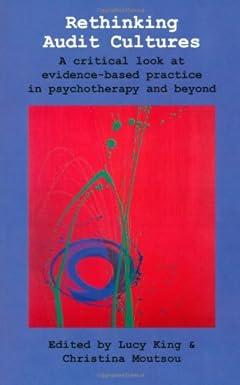Question
WoolCorp buys sheeps wool from farmers. The company began operations in January of this year, and is making decisions on product offerings, pricing, and vendors.
-
WoolCorp buys sheeps wool from farmers. The company began operations in January of this year, and is making decisions on product offerings, pricing, and vendors. The company is also examining its method of assigning overhead to products. Youve just been hired as a production manager at WoolCorp.
Currently WoolCorp makes two products: (1) raw, clean wool to be used as stuffing or insulation and (2) wool yarn for use in the textile industry.
The company would like you to evaluate its costing methods for its raw wool and wool yarn.
Single Plantwide Rate
WoolCorp is currently using the A method that allocates factory overhead to products using a single factory overhead rate across all departments.single plantwide factory overhead rate method, which uses a predetermined overhead rate based on an estimated allocation base such as direct labor hours or machine hours. The rate is computed as follows:
Single Plantwide Factory Overhead Rate = (Total Budgeted Factory Overhead) (Total Budgeted Plantwide Allocation Base)
WoolCorp has been using combing machine hours as its allocation base.
The company would like to consider A cost allocation method that identifies activities causing the incurrence of costs and allocates these costs to products (or other cost objects), based on activity drivers (bases).activity-based costing. In order to understand their current system better, you evaluate WoolCorps current method of costing for raw wool and wool yarn. The production staff has compiled the following information for you on the production of 450 pounds of either raw wool or wool yarn:
Factory Overhead Type Budgeted Factory Overhead Sorting $25,600 Cleaning 38,400 Combing 1,300 Raw Wool Wool Yarn Hours of combing machine use required 80 20 In the following table, use combing machine hours as the allocation base for assigning overhead costs to each product. When required, round your answers to the nearest dollar.
Single Plantwide Factory Overhead Rate: $
per combing hourRaw Wool Wool Yarn Allocated factory overhead cost $ $ Feedback
Activity-Based Costing
In order to compare WoolCorps current method with activity-based costing, you interview the production staff and compile the following information, which relates to the costs for raw wool and wool yarn.
Type of Cost A measure of activity that is related to changes in cost. Used in analyzing and classifying cost behavior. Activity bases are also used in the denominator in computing the predetermined factory overhead rate to assign overhead costs to cost objects.Activity Base Total Cost Sorting Hours of sorting $25,600 Cleaning Units of cleaning machine power 38,400 Combing Hours of combing machine use 1,300 Raw Wool Wool Yarn Hours of sorting required 800 3,200 Units of cleaning machine power required 1,920 4,480 Hours of combing machine use required 80 20 In the following table, compute and enter the The budgeted activity rate divided by total estimated activity-base usage.activity rate for each of the three The types of work, or actions, involved in a manufacturing or service process.activities. If required, round your answers to the nearest cent.
Activity Activity Rate Sorting $ per sorting hour Cleaning $ per unit of cleaning machine power Combing $ per hour of combing machine use In the following table, allocate the costs of sorting, cleaning, and combing based on the rates of activity consumed by each products process. When required, round your answers to the nearest dollar.
Raw Wool Wool Yarn Sorting cost $ $ Cleaning cost Combing cost Total cost $ $
Step by Step Solution
There are 3 Steps involved in it
Step: 1

Get Instant Access to Expert-Tailored Solutions
See step-by-step solutions with expert insights and AI powered tools for academic success
Step: 2

Step: 3

Ace Your Homework with AI
Get the answers you need in no time with our AI-driven, step-by-step assistance
Get Started


